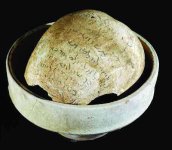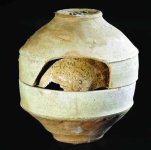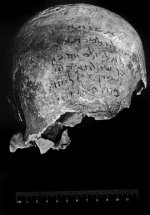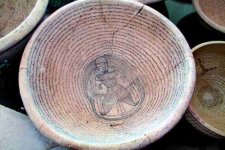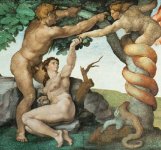Rare Magic Inscription on Human Skull
Wednesday, March 11, 2009
Only five skulls inscribed with Jewish Aramaic Incantation magic texts have come to light, none from professional Excavations. Like the others before it, this skull, acquired by collector Schlomo Moussaieff, raises more questions than it answers. Its relationship to the more common genre of Incantation bowls and its use in a rite or magic seem clear enough. But until more information emerges, basic questions-how this skull was used, for whom, by whom and for what reason-Remain Unanswered.
Not long ago, the well-known collector Schlomo Moussaieff acquired two earthenware bowls, the open ends of which were adjoined to form a kind of case inside the case was an ancient human skull. A magic Incantation, written in Aramaic, was inscribed on the skull.
BAR readers already know about the more than two thousand magic Incantation bowls that have survived from third-seventh-century CE Jewish communities in Babylonia.
The Incantation bowls were made at the same time and in the very communities that produced the most intricate, complex and revered accomplishments or rabbinic Judaism, the Babylonian Talmud. Although some have Incantation Deemed the literature to be inconsistent with the spirit of the Talmud, recent research has shown it to be, rather, complementary and representative of aspects of life reflected within the Talmud.
Wednesday, March 11, 2009
Only five skulls inscribed with Jewish Aramaic Incantation magic texts have come to light, none from professional Excavations. Like the others before it, this skull, acquired by collector Schlomo Moussaieff, raises more questions than it answers. Its relationship to the more common genre of Incantation bowls and its use in a rite or magic seem clear enough. But until more information emerges, basic questions-how this skull was used, for whom, by whom and for what reason-Remain Unanswered.
Not long ago, the well-known collector Schlomo Moussaieff acquired two earthenware bowls, the open ends of which were adjoined to form a kind of case inside the case was an ancient human skull. A magic Incantation, written in Aramaic, was inscribed on the skull.
BAR readers already know about the more than two thousand magic Incantation bowls that have survived from third-seventh-century CE Jewish communities in Babylonia.
The Incantation bowls were made at the same time and in the very communities that produced the most intricate, complex and revered accomplishments or rabbinic Judaism, the Babylonian Talmud. Although some have Incantation Deemed the literature to be inconsistent with the spirit of the Talmud, recent research has shown it to be, rather, complementary and representative of aspects of life reflected within the Talmud.

